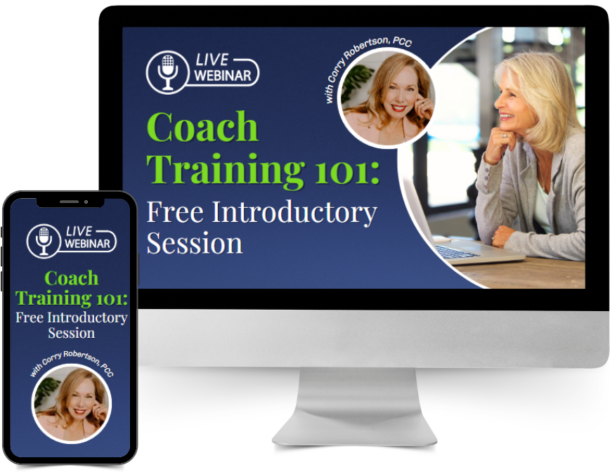Annual Strategic Planning: The Coach Approach
Having a strategic plan for your business is like having a compass when you go hiking in the woods. It’s like taking a map with you before you head off on an adventure to a new place.
If you’re a very small company you may feel that having your plan in your head is good enough. But once you start having to communicate your plan with others, you need to structure your strategy in a way that others can understand and be inspired by.
At this time of year, many leaders are beginning to think about strategic planning, so let’s talk about how to bring the coach approach to business planning, organizational development and performance management.
Pulled from the coaching toolbox, here are some activities and discussion points to consider including in your annual strategic planning session:
Discuss Your Purpose, Vision and Mission
It all starts here. Include a good chunk of time to flush out or update these critical concepts:
What is our purpose as an organization?
What is better for stakeholders because we exist? Consider customers, employees, owners, suppliers, the environment, the community, etc
What is our vision?
What will the ‘world’ look like when we are successful? What will be better for our stakeholders? What positive impact do we make? This statement should be written in terms of the positive, as though it has already come true.
What is our mission?
How do we go about living our purpose and making our vision a reality? What actions do we take? How do we behave? How do we make our choices? What do we say YES to and what do we say NO to? What behaviours reflect our values? What behaviours do we refuse to tolerate?
Introduce Balance Scorecard Action Planning
Kaplan and Norton of Harvard University introduced The Balance Scorecard as a strategic management approach.
The Balance Score card allows senior executives to clarify their vision and co-create a strategy to achieve the vision by identifying and mapping strategic objectives.
To achieve this leaders need to reach consensus on how their objectives are linked to the deliverables that lead to achieving the vision.
Each of the Four Perspectives are interconnected and interdependent. Done well, each perspective supports the success of the other in a positive perpetual cycle.
The Four Perspectives of the Balance Scorecard
Financial: What are our financial objectives?
Customer: To meet our financial objectives, what customer needs must we fulfill?
Process: What internal processes and operations do we need to serve our customer needs? (knowing that the better we serve the customer’s needs, the better our financial return will be.)
Learning and Growth: What do we need to learn, change, do more of, do less of to smoothly run the internal processes to meet the customer needs and reach our financial objectives?
Learning and growth also considers the intangible aspects that are required to drive performance such as culture strategy, leadership development, technical skills training, working conditions and environment.
Cause and effect logic of the balance scorecard:
The scorecard helps us live up to our mission because
Learning and growth supports the success of the
Internal processes and operations
Which helps deliver on customer needs
Which helps us achieve our financial objectives
Which helps fulfill our purpose, achieve our vision
Fleshing Out The Perspectives
Taking each perspective individually (financial, customer, process, learning + growth) complete answers should be co-created for:
1. Objectives: What outcome are you going to achieve? What is the AIM or the desired result?
2. Initiative: What actions are you going to undertake to achieve the objective?
3. SMART Goals: what goals do you need to set? These must be in alignment with the initiatives directed towards the objective. SMART stands for Specific, Measurable, Achievable, Relevant and Time Framed.
4. KPI: Key performance Indicators help you determine if you are on track, on time, on budget.
Getting An Outside Perspective
I strongly recommend that you hire a professional facilitator to guide you and your management team through this process.
Often the President and CEO of the company believes it should be their job but I guarantee that this is counter intuitive.
They also need to contribute, brainstorm and participate in this meeting and they can’t do that if they are leading it.
AND leaders absolutely cannot see their own blind spots. A professional facilitator will provide you with the outside perspective that will lead to growth and insights you likely won’t achieve otherwise.
Conclusion
In “Built To Last: Successful Habits of Visionary Companies”, James Collins and Jerry Porras show that enduring success can be attributed to two factors:
1. Great organizations preserve a passionately held core ideology (their purpose, their values, what they stand for, who they are).
2. Great organizations never stop stimulating progress in every part of the operation except the core ideology.
The annual strategic meeting, when done correctly, can help you to refocus on your core principles and stretch yourself in areas where you need to be challenged.
When you add in the coach approach to discussing your purpose, vision and mission, as well as using the balance scorecard action planning steps, you have a winning combination that stimulates progress AND preserves the core ideology.
In simpler terms, you have a compass when you are out hiking in the woods. You have a map in your back pocket. You are setting yourself and your organization up for success.
Here’s to your success!
Enjoyed this article? Read my companion piece:
Ditch The Annual Review: The Coach Approach to Performance Management
You might also like:
Workplace Culture Changes: Shifting Values and the Need For Leadership
10 Steps To Giving Feedback that is Well Received and Sticks!
A Peek Inside A Successful Leadership Development Program







0 Comments